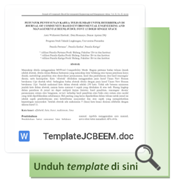Identification of Sludge Production In Water Treatment Installations of Urban Drinking Water Companies
DOI:
https://doi.org/10.23969/jcbeem.v6i1.5247Keywords:
drinking water treatment, sedimentation, sludgeAbstract
The by-product of sludge generated at the Water Treatment Plant can affect water quality degradation if disposed of directly without any prior treatment. As a company engaged in water management, the urban drinking water companies produce sludge in every production activity. This study aimed to identify the flow of sludge generation at the Water Treatment Plant, the quantity of sludge generated at the sedimentation unit, and the quality of the wastewater generated at the Sludge Treatment Plant. The identification results show that the flocculation, sedimentation, and filtration units produce sludge transported to the sludge treatment unit (SCP and SDB). The quantity of sludge generated in the sedimentation unit in March and April are 1,887m3/day and 1,474m3/day, respectively. The physical and chemical quality (pH, temperature, TDS) of wastewater produced by the sludge treatment unit are still below the quality standard based on PERMENLHK No. 5 of 2014, concerning Wastewater Quality Standards for Businesses or Activities That Do Not Have Wastewater Quality Standards.
Downloads
References
Adityosulindro, S., Hartono, D. M., & Pramusinto, A. C. (2013). Evaluasi Timbulan Lumpur dan Perancangan Sistem Pengolahan Lumpur (Studi Kasus: Instalasi Pengolahan Air Minum Cibinong, Jawa Barat). Lingkungan Tropis, 7(2), 131-146.
Adriansyah, A. A. (2017). Keterkaitan antara Sanitasi Pondok Pesantren dengan Kejadian Penyakit yang Dialami Santri di Pondok Pesantren Sunan Drajat. Medical Technology and Public Health Journal, Vol 01 No 01: 4-13 .
Ahmad, J., & El-Dessouky, H. (2008). Design of a modified low cost Treatment system for the recycling and reuse of laundry waste water. Resource, Conservation and Recycling, 52(1), 973-978.
Cornwell, D., Bishop, M., Gould, R., & Vandermeyden, C. (1987). Handbook of practice: WaterTreatment Plant Waste Management. Denver (US): AWWA Research Foundation.
Julian, D. A., Lindum, M., & Winarni. (2015). Studi Pengolahan Lumpur Instalasi Pengolahan Air Minum Taman Kota - Jakarta Barat. Jurnal Teknik Lingkungan, 7, 75-80.
Kawamura, S. (2000). Integrated Design and Operation of Water Treatment Facilities 2nd ed. New York: John Wiley & Sons.
Manual/AWWA, A. (1996). Technology Transfer Handbook : Management of Water Treatment Plant Residual. Denver: AWWA.
Pradana, M., & Reventiary, A. (2016). Pengaruh Atribut Produk terhadap Keputusan Pembelian Sepatu Merek Customade (Studi di Merek Dagang Customade Indonesia). Jurnal Manajemen, Vol.6 No. 1: 1-10.
Pratiwi, R., Rachmawati, S., & Pharmawati, K. (2015). Perbandingan potensi berat dan volume lumpur yang dihasilkan oleh IPA Badak Singa PDAM Tirta Wening Kota Bandung menggunakan data sekunder dan primer. Reka Lingkungan, 1(3), 1-11.
Qasim, S. R., Motley, E. M., & Zhu, G. (2000). Water Works Engineering : Planning, Design, and Operation. New Jersey: Prentice Hall PTR.
Santoso, R., & Husni, A. (2008). Sebaran TDS, DHL, Penurunan Muka Air Tanah dan Prediksi Intruisi Air Laut di Kota Tangerang Selatan. 2008: Teknik Sipil dan Lingkungan IPB.
Sidhi, A. N., Raharjo, M., & Dewant, N. A. (2016). Hubungan Kualitas Sanitasi Lingkungan dan Bakteriologis Air Bersih terhadap Kejadian Diare pada Balita di Wilayah Kerja Puskesmas Adiwerna Kabupaten Tegal. Jurnal Kesehatan Masyarakat , Vol 4, No 3: 665-676.
Tchobanoglous, G., Burton, F., & Stensel, H. (2004). Wastewater Engineering: Treatment and Reuse.4th ed. New York: Mc Graw Hill.
Kobya, M., Senturk, E., & Bayramoglu, M. (2006). Treatment of poultry slaughterhouse wastewaters by electrocoagulation. Journal of Hazardous Materials, 133(1–3), 172–176. https://doi.org/10.1016/j.jhazmat.2005.10.007
Pintor, A. M. A., Vilar, V. J. P., Botelho, C. M. S., & Boaventura, R. A. R. (2016). Oil and grease removal from wastewaters: Sorption treatment as an alternative to state-of-the-art technologies. A critical review. Chemical Engineering Journal, 297, 229–255. https://doi.org/10.1016/j.cej.2016.03.121














